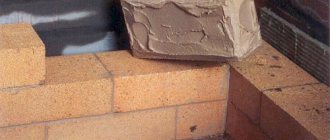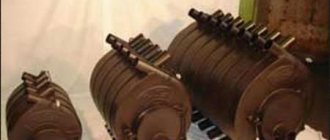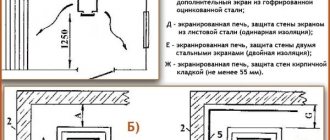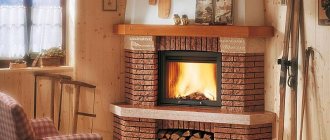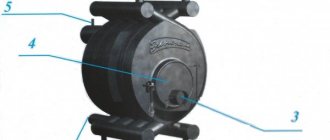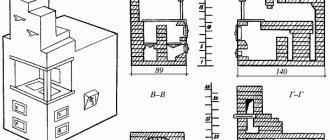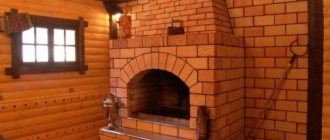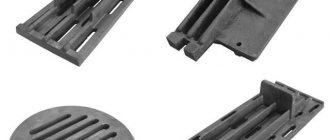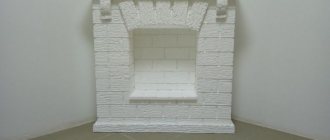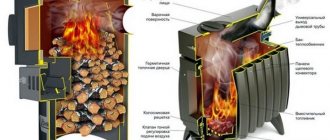Even a properly laid brick oven will require repairs over time. High temperatures, traction problems, mechanical damage to the masonry - all this leads to the appearance of defects that require elimination. After all, good traction and the absence of cracks in the walls are the key to safe operation of the stove. Let's see today what types of damage to the stove masonry can be repaired yourself, without resorting to the expensive services of a stove-maker.
Below in the article you will find the main ways to eliminate defects that have appeared in the stove masonry and advice from experts who will help you make repairs of the highest quality. Let's see how to replace the stove door and how to improve the draft if it has become worse over time.
The main problems of a brick kiln
The most common problems that arise when using a brick oven include the following:
- Reduced cravings. This leads to slower burning of the fuel and slower heating of the stove itself. If the draft is poor, smoke can flow from the firebox into the room through leaks in the firebox door. The same thing happens when the wind increases outside, when the wind blows smoke into the chimney. This problem can cause the appearance of carbon monoxide, a deadly, colorless, odorless substance that accumulates indoors.
- The destruction of masonry in certain places, the appearance of cracks through which combustion products escape, and the loss of heat necessary to warm up the stove.
- Uneven heating of different areas of the oven.
- Rapid cooling of the stove after combustion in the firebox stops. The oven does not hold heat and cools down quickly.
- Loosening or falling out of the combustion door fastening parts.
Any of these defects requires attention and, if possible, rapid elimination. How to do this and what can cause them to appear, read below.
Oven door repair
The simplest repair can be considered the elimination of loose fasteners of the combustion door. Sometimes the door attachment points begin to collapse due to uneven thermal expansion of the metal and brick into which the metal door is mounted using mortar.
After some time, the leaks increase and if the draft is disrupted, smoke begins to seep into the opened cracks, and air begins to enter the firebox not through the lower part of the grate, but from above, immediately flying into the chimney and not contributing to combustion.
To avoid this, it is best to secure the combustion door using metal brackets, pieces of wire, or simply by screwing galvanized plasterboard hangers onto it with self-tapping screws, as shown in the photo below:
These perforated steel strips, sticking out in different directions, fit perfectly into the seam of the brickwork and are sealed with mortar, tightly securing the door:
Flame simulation doesn't work
Repair is possible when the flame arises from the light of a lamp penetrating through a rotating disk. A burnt-out lamp must be replaced. But if it is not possible to buy a red lamp, then you can paint a regular one with varnish, having first degreased its bulb.
After repairing elements of the electrical circuit, be sure to ensure that the wiring is shorted to the housing. When the switch keys are turned on, the resistance between the plug pin and the body is measured. A renovated fireplace that is turned on should not be left unattended for some time.
As you can see, in most cases, in order to repair the system, you need to have some skills in working with household appliances, so if you don’t have these, it’s better to entrust the work to a specialist.
What to do if cravings worsen?
Good stable draft is necessary to maintain the correct combustion mode, which requires the supply of the required amount of oxygen to the firebox and the unhindered removal of combustion products - smoke, soot, soot, as well as gases formed during the combustion of fuel.
If any of these two necessary conditions are violated, the operation of the stove may become unsafe and lead to the accumulation of harmful gases in the room.
During the construction of the furnace, gas ducts (chimneys) of the required size are installed, capable of passing the amount of smoke that is generated during the combustion of fuel. But, over time, a thick layer of soot accumulates on the walls of the flues, which reduces the cross-section of the chimney and prevents the free passage of exhaust flue gases, creating additional resistance to their movement.
As a rule, the appearance of a large amount of soot is associated with the use of firewood containing a large amount of resinous substances, which do not have time to burn completely and fall out on the walls in the form of layers of soot. Damp firewood also produces a large amount of soot.
To improve draft in this case, cleaning the pipe that removes smoke from the firebox will help. You can read how to do this in the article “How to clean a bathhouse chimney.” Also, the draft may be disrupted due to leaks in the stove lining, cracks in the walls and in the masonry of the chimney. Moreover, destruction of the masonry can occur not only within the heated room, but also outside the building - if the pipe masonry on the roof cracks and collapses, the draft will also be disrupted. Read below on how to eliminate cracks that appear.
Troubleshooting and troubleshooting
All consumers, according to their mentality, are conditionally divided into two categories:
- The first believe that everyone should take care of their responsibilities. If there is a service for repairing household appliances, then specialists should diagnose and repair fireplace malfunctions.
- The latter believe that any device was created by a person, which means that anyone can repair it.
Experienced craftsmen who have repaired electric fireplaces more than once advise sticking to the “golden mean”, since, despite the apparent complexity, the operating principle of the heater is quite simple. But at the same time, modern technologies make it possible to install some components in such a way that they become irreparable and must be replaced as entire units.
The algorithm of action in case of breakdown of electric fireplaces is simple and standard: determine the source, determine the degree of its maintainability, repair (replace). It’s worth mentioning right away that there are very serious breakdowns (display, ultrasonic generator, control chip), which will have to be addressed to a specialized company. But according to statistics, most faults can be corrected independently.
The technician examines the device and looks for faults
Repairing brickwork and eliminating cracks in the furnace
A more complex type of repair is eliminating cracks in the masonry and replacing burnt bricks with new ones. The causes of cracks may be the following factors:
- overheating the furnace;
- foundation shrinkage;
- reducing the volume of masonry during drying;
- errors in installing doors;
- incorrect ratio of sand and clay in masonry mortar;
- non-compliance with masonry technology.
Cracks that appear in the masonry cannot be ignored, since not only does heat loss occur through them, but their presence also leads to a disruption in draft and the leakage of flue gases into the room. Therefore, if you notice a crack, you should take timely measures to eliminate it.
It is not always advisable to replace bricks where cracks appear. If they are not burnt out, have sufficient strength and can still serve, they can be left, but the gap that appears will need to be repaired. To seal cracks in the masonry, it is recommended to use a similar composition that was used when laying the entire furnace, so that the coefficient of thermal expansion of the masonry and the composition that will be used to seal the leaks is, if possible, the same. This will avoid the appearance of new cracks as a result of uneven expansion of the masonry during heating. Typically, a clay mortar for masonry is used for this, mixed from high-quality clay and quarry sand in the required proportion (1:1-1:3) or purchased mixtures for laying stoves and sealing cracks in stoves and fireplaces.
You can also use special high-temperature mastics for stoves and fireplaces, the composition of which has good plasticity, does not crack after drying and can withstand multiple heating/cooling cycles of the masonry without damage. The photo below shows Bolars KaminFix universal mastic for fireplaces, tiles and natural stone:
With this composition you can seal the heating surfaces of a brick oven without fear that the seams will separate after heating. To seal a crack in a mortar joint, you need to use tools to select the cracked mortar to a depth of 2-3 cm and replace it with oven putty, which, after hardening, will ensure the necessary tightness of the masonry.
If the stove is old, but you are not yet ready to carry out a major overhaul with the relocation of some areas, then you can repair the main leaks that have arisen as a result of cracking, as shown in this video:
Replacement of damaged bricks and removable cast iron elements
During the operation of a brick kiln, there is often a need to replace burnt out or damaged bricks. To do this, you need to remove the damaged brick, and completely clean the place where it was located from all sides of old mortar and soot and thoroughly moisten it with water. Then put a new mortar on the bottom layer of the masonry, lower the inserted brick into water for a couple of seconds, put a layer of mortar on top and sides of it and insert it into the formed niche.
One of the most common types of repairs for brick stoves is strengthening or replacing its cast-iron elements: combustion and view doors, grate and, in fact, the stove. The easiest thing to do here is to replace the grates. Since the grate is laid without clay mortar, it is enough to simply remove the old grates, having first carefully examined how they were laid, and put new ones in their place in the same way.
Often, when operating a brick oven, the cast iron stove is damaged. Today, their quality leaves much to be desired, and with constant alternation of heating and cooling, the material, unable to withstand it, bursts into two or even more pieces. The same can happen due to improper installation of the stove. But it is also possible that a slab in a dacha or in a house can still be used, but due to damage to the bricks on which it is laid, it has lost the necessary support, and cracks have appeared between the brick and the slab.
In the first case, you need to replace the stove with a new one. But we must keep in mind that the slabs may differ in size. When purchasing a new stove, do not forget to accurately measure the dimensions of the old one. The new slab should be the same in size as the old one, at most 10-15 mm larger, but in no case smaller. Otherwise, instead of simply replacing the stove, you will have to redo the entire firebox.
Finishing the stove with decorative masonry.
In the second case, there is no need to purchase a new slab, but you will have to replace the damaged bricks of the top row, or, even more reliably, replace the entire top row of bricks.
You can use a carpenter's ax to remove the old slab. The ax blade is inserted from the side under the slab and, using the ax handle as a lever, it is lifted. Then do the same on the other side of the slab. After this, the plate can be easily removed.
The method of replacing damaged bricks was discussed above. Relaying the top row is carried out according to the same principle: first, the old bricks are carefully removed. Here the technology is simple: drive a thin but wide blade of a chisel or chisel under the brick from below (you can also use a knife with a wide blade), pull the handle and tear the brick out of place, after which it is easy to pull it out. You need to start with the most damaged brick, since the first brick is the most difficult to tear off. Then they do the same with the second brick and take them all out one by one.
The surface of the bricks of the bottom row is thoroughly cleaned of clay mortar and soot, thoroughly moistened with water and a new row of bricks is placed on top, observing, of course, their dressing. When installing the stove, you need to remember that cast iron tends to expand when heated, so under no circumstances should the stove be firmly fixed.
It’s easier if a new slab is placed in place of the old one and matches it in size. In this case, the place where the slab will be placed is cleaned of any remaining clay mortar and soot, the slab is installed and the cracks are sealed with freshly prepared mortar. If the slab is placed on new bricks, then you must first make a recess in them along the perimeter of the slab, and the dimensions of the recess on each side should be 5-7 mm larger than the dimensions of the slab; Place a slab in the recesses and seal with freshly prepared mortar.
Masonry repair
If it is necessary to replace a section of masonry, the work is carried out in the following sequence: - first, you should carefully remove the bursting burnt bricks; - unstitch the seams around the area to be replaced (you can use a drill or hammer drill with an impact mechanism); — thoroughly clean everything from dust and debris (it is best to use a vacuum cleaner); — wet the areas where the solution is applied with water (in hard-to-reach places you can inject water from a syringe); - select bricks of suitable size, apply masonry mortar and move the burnt area. For masonry, you should use a special solid red refractory brick. You can find out more about how to choose a brick for laying a stove in the publication Which brick is better to choose for laying a stove?
